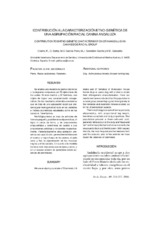Mostrar el registro sencillo del ítem
Contribución a la caracterización etno-genética de una agrupación racial canina andaluza
| dc.contributor.author | Barba Capote, C.J. | |
| dc.contributor.author | González-García, M.J. | |
| dc.contributor.author | Camacho Vallejo, M.E. | |
| dc.contributor.author | García-Pozo, M.C. | |
| dc.contributor.author | Castro, R. | |
| dc.date.accessioned | 2010-04-13T09:57:45Z | |
| dc.date.available | 2010-04-13T09:57:45Z | |
| dc.date.issued | 2000 | |
| dc.identifier.issn | 1885-4494 | |
| dc.identifier.uri | http://hdl.handle.net/10396/2945 | |
| dc.description.abstract | We are analysing a sample of 53 animals (16 males and 37 females) of Andalusian mouse hunter dogs or caves dog, with a view to obtain their ethnogenetic characterisation. From our results we have concluded that this population is a racial group presenting a great homogeneity in the variables and zoometric indexes studied, as in the phaneroptical aspects. Their morphology is as a small format, probably elipometrics, with proportional leg length, brevilineous cephalic and body proportions. This population present a three-coloured coat, generally white colour on the body and “black and tan” on the head; the hair is short and smooth, the mucosae is black and the iris brown. With respect the bite, the most frequent are the tweezers form and the scissors, also in few animals we have found the absence of premolars. | en |
| dc.description.abstract | Se analiza una muestra de perros ratoneros o bodegueros compuesta por 53 ejemplares de los cuales 16 eran machos y 37 hembras, con objeto de lograr una caracterización etnogenética. De los resultados obtenidos concluimos que se trata de una agrupación racial que presenta gran homogeneidad tanto en las variables e índices zoométricos estudiados como en los aspectos fanerópticos. Morfológicamente se trata de animales de formato pequeño, posiblemente elipométricos, ni lejos ni cerca de tierra, y de proporciones braquicéfalas y brevilíneas en cuanto a sus proporciones cefálicas y corporales respectivamente. Fanerópticamente esta población presenta una capa tricolor, generalmente blanco en el cuerpo y negro-fuego en la cabeza, el pelo corto y liso, la pigmentación de las mucosas negras y el iris castaño. En cuanto a la mordida los tipos más frecuentes son en tijera y pinza, y en un escaso número de ejemplares existe ausencia de premolares. | es_ES |
| dc.format.mimetype | application/pdf | es_ES |
| dc.language.iso | spa | es_ES |
| dc.publisher | Universidad de Córdoba, Servicio de Publicaciones | es_ES |
| dc.rights | https://creativecommons.org/licenses/by-nc-nd/4.0/ | es_ES |
| dc.source | Archivos de zootecnia 49 (185-186), 253-257 (2000) | es_ES |
| dc.subject | Perros | es_ES |
| dc.subject | Raza autóctona | es_ES |
| dc.subject | Ratonero | es_ES |
| dc.subject | Recursos genéticos | es_ES |
| dc.title | Contribución a la caracterización etno-genética de una agrupación racial canina andaluza | es_ES |
| dc.title.alternative | Contribution to ehtno-genetic chatacterisation of anandalusian canine dog racial group | en |
| dc.type | info:eu-repo/semantics/article | es_ES |
| dc.relation.publisherversion | http://www.uco.es/organiza/servicios/publica/az/az.htm | es_ES |
| dc.rights.accessRights | info:eu-repo/semantics/openAccess | es_ES |

